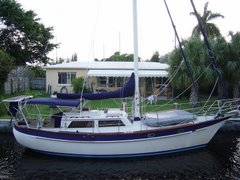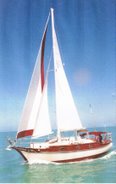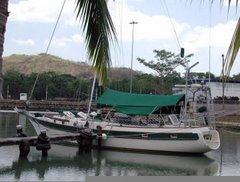
"Alice's Restaurant"
what a movie!
Do you remember the funny scene where Officer Obie and his crew were taking photos of the garbage Woody and the gang threw off the side of the road?
The Photos: " Glossy 8"x 10" black and white's, with circles and Arrow's/depicting the location of the garbage and the extent of the Crime Scene!!!" I loved the movie and still love the song but, I am cringing now that I have to be like Officer Obie and show photos! It's good to know and I have been lucky to have recourses for this.
Top of Shaft that would normally be INSIDE the fiberglass of rudder is shown. The shaft shown here, shows only a 1/4" of shaft remaining that would have extended outside/and UP from the fiberglass.

(The Upper section of this rudder shaft has been cut off )
Plenty of corrosion, wear and flaking going on.
Well today I got out my camera and took some photos of a typical 2" CSY rudder shaft.
No circles or arrow's to point to anything. Degredation of the Bronze is evident.
View facing the Top flat bar: The 2" Bronze Shaft: Milled for 3/8" flatbar insertion then drilled for (2) brass dowels. The weak point as I see it, is at this jucture of the machining for the upper flat bar and it's 2 3/8' dowels. Probably NO problem if the metals are not degraded and/or stressed to a breaking point by backing into something underwater....like the bottom!

My eyes first saw the inside of a 'broken CSY 44 rudder, in '88 or '89. It was caused by backing into sand in a remote Caribbean anchorage. I built a new rudder for my boat in '94 as a precautionary measure. From then on, when the subject came up, offered what I could to others. I did not take, nor do I have, any pictures of the broken rudder I worked on in the eighties or the rebuild, but sure wish I did. Eventually, I got tired of 'conversational static' when I would mention the weak spot in design or suggestions/ideas on a fix, as well as a complete failure of the Topica list to be researched by anyone/anytime. For this reason, I started the CSYsailboats site. Now, I'm going to add more comments and photos.
Viewed slightly from the side. Note that the Flat Bar has been cut off prior to photographing and the Pins have been partially pressed out for demonstration purposes. This area is the weak link. Too much material removed by machining.

Some folks have been happy that the written material and photographs are here. Yet others seem to wish I'd .....disappear, and maybe take this subject, text and photos with me! Nah folks, it ain't going to happen!
It has been suggested by others, that when PLAY, CRACKS,VOIDS or any such anomalies were found on the top of their rudder, that a "fix" can be attained by:
1. a flushing with fresh water.
2. allowing time for a drip dry/days, weeks or months.
3. grinding or scraping a trough near the evidence of damage and then-
4. pouring a thinned or.................? thickened? batch of resin into the crack till no more can be added.
5.then simply, paint and launch.
I disagree.

Another side view(Flat Bar cut off) and the dowels partially pressed out for demostration purposses.
Here's why, in no particular order:
-Salt or fresh water has been seeping into these rudders for maybe... 30 years. Any and all sea life-- those slippery little critters that you cannot keep off your one year old bottom paint?! Well they've been living and dying inside every crack that water can enter. To do any meaningful FILL, would require Total Cleaning/abrasion, which is just not possible with a fresh water rinse. Then, a "Fill" of epoxy or almost anthing known to man in the way of a thin enough liquid to get in, can not CREATE a bond that will accomplish what the Bronze Bars were meant to do. The BRONZE BARS pushing against the internal fiberglass, CREATES THE ABILITY TO SAFELY TURN THE RUDDER. .... not a bond of fiberglass slurry to the shaft surface.
-NO amount of flushing will clean the surfaces inside, fiberglass or bronze, to a level (shiny/squeeky clean) that would satisfy any product. The application of anything worth buying for maintenance or repair, calls for a clean surface and probably abraded.
-whatever caused the cracking, play or internal void (that might NOW, accept a volume of liquid) has not been deciphered nor repaired... so there still is NO FIX.
The space has just been filled again by a liquid.(remember, the OEM filled it too).
-For any meaningful protection from water intrusion into a rudder, a seal must exist between the fiberglass and bronze, both top and bottom. The original rudder guru's did not figure this in.
Epoxy and fiberglass eventually will separate due to expansion/contraction or stresses, enough to allow water to ingress without a sealant at the juncture..
Not a hard project once you have everything else done!
-The strength inside the rudder comes from the (3) three, 3/8" x 2" Flat Bars that are pinned to the shaft, then encapsulated with a slurry of resin, within a fiberglass outer shell. If the shaft breaks or the bars snap or just weaken, an epoxy pour will not save the day. The fiberglass needs to be solidly held to the shaft by something and the 'design' specifies that the 3 flat bars to this. In the original design, the Upper bar/shaft point seems to me to be taking the major loading.
-30 years underwater, electrolysis, galvanic action, stresses, miss adventures by skippers and a weakened shaft 'by design', at the point of most stress, leads me to say; "Hey! let's look at some pictures." These seem to reflect what I remember from and later, with minor exceptions.
This shaft does not look bad at all. Minimal de-zincking (shown by reddish color usually on surface then going deeper).
Problem week point. The 2" shaft has been machined to accept the 2" flat bar and then at this same location but coming in at 90 degrees, the shaft has been drilled out for (2), 3/8" brass pins to hold the flat bar. All in all, nearly 1/2 of the shaft has been machined away at this point. The Machining done at the Upper Bar is the "Weak link in the chain".
It is at This Point, that these shafts have broken in the past, the Upper Flat Bar.
It was inserted into the shaft 7" down from upper surface of rudder. So now ask, what is worse? Reduction in material strength due to years of electolosis/dezincking the shaft/corrosion(you chose the term, or when manufactured--- removing nearly half the material of the shaft? I don't see a difference that would effect my confidence. It's also been proven that some boats have both.
While this shaft does not look as bad as the 4 others I've seen out and close up, it should be clear that this shaft is not in great shape inside. I did not grind away near the upper bearing location, but it is clear that there is significant deterioration of the surface and some cracking and flaking away of the bronze noted.

John Nunenmaker did not try to rebuild his rudder, once he dropped it from his boat for inspection. He saw immediately that the area around the gland/bearing surface was worn and de-zincked. He ground down more than 1/4" into the area to see how far the metal had deteriorated and quit as he was way too deep into the shaft for his comfort level. He's glad he now has new material and still quite satisfied he did the project.
Click on this drawing, or any photo to enlarge
I asked him if he had any second thoughts about his choice to not use his old rudder. He laughed and said something like "Hell No!".
The Nunenmakers are departing in 6 weeks or so on their beautifully redone, CSY 44 W.O. "FREEDOM"
As John said to me today, "Ron we are among a fraction of the One Percent." We laughed but maybe he is right.
We fix what we have to our standards and build things we can count on. (Some photos of Johns rudder job are on the other Rudder Post if you care to see his work.)
Corrosion, flaking, cracking within the top inch of the normally encapsulated shaft.

To answer a question brought up days ago asking for information on rudders rebuilt, repaired etc. I can only list what I know in my area. Except for one, these are all boats local to my area.
1989 "Whatever" 44' PH New Broken*
1994 " Memory Rose" 44 PH New Preventative
1999 " Rhapsody" 33 New Broken
2000 "Dixie Jo" 44 WO Replaced Broken**
2000 "Peter Rabbit" 44 WO New Preventative
2000+/- "Butterfly's Dream 44 WO ? Damaged
2002-4? "Chanticleer" 44 WO New Preventative but orig. rdr. needed repair.
2007/8 "Freedom" 44 WO New Preventative
*note that the first rudder to break was only 11 years old. Corrosion was not the problem- it broke from forces of backing into sand. It can happen to anyone, but now you know what is inside and maybe how to effect a repair or design a new one.
** backing in a canal
I can understand the reason NOT to address this.
1. I did not know about it or I don't want to know about it.
2. I don't know how to fix it.
3. It's too much of a project for me
4. It costs to much
5. There are no such repair facilities around here.
6. I don't trust a 'one off design' of another.
7. I only daysail and my insurance covers tows back to my dock
8. I'm going to sell my boat soon so let the next guy take care of it.
9. Never heard a thing about it!
All might have validity. Your choice
I feel for those who pay good money for a good boat, so they can really go somewhere and do something, and also, already understand the obvious things like the cost of sails(one alone can cost more than a complete rudder), rigging, roller furlers, bimini's, cushions, interiors, stoves, engines etc. etc. etc, that, a few grand for something like a good solid rudder should not be such a heart stopper!
Be serious. IF you were to drive an old (30 yr. old) car around town few of us would do it on 30 year old tires, but: you could live with it, locally, until a tire blows.
Would you drive the interstate or off road with it to Alaska?...loaded down with the family and another 3 tons of goodies? Maybe a storm or two along the way? No repair centers in the w
 oods?
oods?I doubt it.
What is different?
If you can replace everything above deck and inside and have bucks for everything else including a ton of spares, stereos, microwaves, t.v.'s and pretty things all around the boat, maybe one should consider the few but important items that will keep you and yours.....safe.
That's all I'm saying, isn't it.
An added thought. If you KNOW your boat; you have owned it forever and KNOW you have not physically damaged it by backing into anything, then you might be just fine! If you know your electrical stuff and have never had to replace your Through Hulls etc. because of galvanic/electrolosis etc. then, you are fine! If there is a problem with your under water metals in one area, then you probably have problems in ALL areas. If your Through Hulls are fine, the chances are your Rudder is fine.
However, If you are not the original owner, trust only your eyes or your intuition.





No comments:
Post a Comment